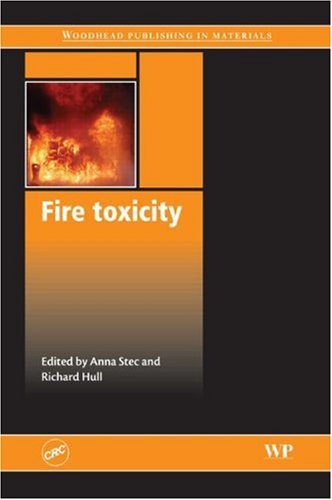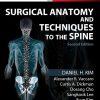(Ebook PDF) Fire Toxicity 1st Edition by Anna Stec, Richard Hull ISBN 9781845698072 184569807X full chapters
$50.00 Original price was: $50.00.$35.00Current price is: $35.00.
(Ebook PDF) Fire Toxicity 1st Edition by Anna Stec, Richard Hull -Ebook PDF Instant Download/Delivery:9781845698072, 184569807X
Instant download Full Chapter of Fire Toxicity 1st Edition after payment

Product details:
ISBN 10:184569807X
ISBN 13:9781845698072
Author: Anna Stec, Richard Hull
Toxic fire effluents are responsible for the majority of fire deaths, and an increasing large majority of fire injuries, driven by the widespread and increasing use of synthetic polymers. Fire safety has focused on preventing ignition and reducing flame spread through reducing the rate of heat release, while neglecting the important issue of fire toxicity. This is the first reference work on fire toxicity and the only scientific publication on the subject in the last 15 years.
Assessment of toxic effects of fires is increasingly being recognised as a key factor in the assessment of fire hazards. This book raises important issues including the types of toxic effluents that different fires produce, their physiological effects, methods for generation and assessment of fire toxicity, current and proposed regulations and approaches to modelling the toxic impact of fires.
The contributors to Fire toxicity represent an international team of the leading experts in each aspect of this challenging and important field. This book provides an important reference work for professionals in the fire community, including fire fighters, fire investigators, regulators, fire safety engineers, and formulators of fire-safe materials. It will also prove invaluable to researchers in academia and industry.
Table of Contents:
- Part I Introduction
- 1 Introduction to fire toxicity
- 1.1 Fire toxicity
- 1.2 Hazards to life from fire
- 1.3 Important toxicants
- 1.4 Quantification of toxic hazards from fire
- 1.5 Bench-scale generation of fire effluents
- 1.6 Fire death and injury statistics
- 1.7 References
- 2 Fire scenarios and combustion conditions
- 2.1 Introduction
- 2.2 Idealised fire growth and typical toxic products
- 2.3 Studies onmethane flames
- 2.4 The equivalence ratio ø
- 2.5 Types of fire and stages of growth
- 2.6 Combustion conditions in full-scale compartment fires
- 2.7 Conclusions
- 2.8 References
- Part II Harmful effects of fire effluents
- 3 Hazards from smoke and irritants
- 3.1 Introduction
- 3.2 Hazard assessment issues in relation to smoke and irritants
- 3.3 Effects of smoke obscuration and irritancy on escape and tenability
- 3.4 Why irritants are an important aspect of fire hazard
- 3.5 Range of irritant effects and importance of concentration and exposure dose
- 3.6 Concentration and dose-response relationships
- 3.7 Similarities and differences between animal species in relation to effects of irritants
- 3.8 Potency ranges for sensory and lung irritancy
- 3.9 Setting tenability limits for concentration and dose-related irritant effects
- 3.10 ASET FED calculationmodels for time to incapacitation and lethal dose of irritants
- 3.11 Calculating the effects of sensory irritancy on walking speed
- 3.12 Conclusions
- 3.13 References
- AppendixA:Comparison of FEC, Cn t and RD models for calculating time to and severity of sensory irri
- Appendix B: Setting tenability limits for irritants
- 4 Asphyxiant components of fire effluents
- 4.1 Introduction
- 4.2 Asphyxia, hypoxia and asphyxiant fire gases
- 4.3 Dose–effect relationships and uptake rate calculation methods for individual gases and interac
- 4.4 Carbonmonoxide
- 4.5 Hydrogen cyanide
- 4.6 Low oxygen hypoxia
- 4.7 Interactions between the effects of different asphyxiant gases
- 4.8 Conclusions
- 4.9 References
- 5 Effects of fire effluents on fire victims
- 5.1 Introduction
- 5.2 Legal aspects of the investigation of sudden or unnatural deaths
- 5.3 Death investigation
- 5.4 The pathology of heat trauma
- 5.5 Examination of the victims
- 5.6 Fire effluents
- 5.7 Conclusions
- 5.8 References
- Part III Biological assessment of fire toxicity
- 6 Experimental methods in combustion toxicology
- 6.1 Introduction
- 6.2 Principles of toxicology and toxicity
- 6.3 Descriptive animal toxicology tests
- 6.4 Standardisation and validation of alternative methods
- 6.5 Conclusions
- 6.6 References
- 7 Animal exposure studies
- 7.1 Introduction
- 7.2 Principles of combustion inhalation toxicology
- 7.3 Bioassays
- 7.4 Exposure systems for the study of inhalation toxicity
- 7.5 Principles of hazard identification and risk characterisation
- 7.6 Inhalation toxicity testswith fire effluents: end points
- 7.7 Non-lethal end points
- 7.8 Acute inhalation toxicity of combustion products: examples
- 7.9 Conclusions
- 7.10 Future trends
- 7.11 References
- 8 Application of human and animal exposure studies to human fire safety
- 8.1 Introduction
- 8.2 The development of toxic hazards in fires
- 8.3 Toxicity of individual fire gases and toxic potency of different materials
- 8.4 Fractional effective dose methodology for hazard analysis
- 8.5 Similarities and differences between animal models and humans
- 8.6 Identification of toxic species in fire effluents and assessment of contributions to toxic hazar
- 8.7 Conclusions
- 8.8 References
- 9 biological toxicity assessments for fire combustion products
- 9.1 Introduction
- 9.2 Combustion furnace
- 9.3 In vitro toxicology
- 9.4 Future trends
- 9.5 References
- 10 A combined fire smoke and lung model test equipment
- 10.1 Introduction
- 10.2 Results
- 10.3 Discussion
- 10.4 Conclusions
- 10.5 References
- Part IV Toxicity assessment using chemical analysis
- 11 Sampling and measurement of toxic fire effluent
- 11.1 Introduction
- 11.2 Sampling fire effluents: general principles
- 11.3 Practical arrangements for a typical sampling line for fire effluent gases and vapours
- 11.4 Analysis of gaseous fire effluents: general principles
- 11.5 Analysis of fire effluents: summary of principal methods available
- 11.6 Sampling and analysis of aerosols
- 11.7 Lower limits of detection, quantification, accuracy and precision
- 11.8 References
- Appendix A Summary of sampling and analytical methods for fire gases and vapours
- Appendix B Table of analytical methods for aerosols
- 12 Bench-scale generation of fire effluents
- 12.1 Introduction
- 12.2 Bench-scale generation of fire effluents: general requirements
- 12.3 Classification of testmethods
- 12.4 Flow-throughmethods
- 12.5 Overall comparisons between bench and large scales
- 12.6 Conclusions
- 12.7 References
- 13 Large-scale generation and characterisation of fire effluents
- 13.1 Introduction
- 13.2 Fire characterisation
- 13.3 Sampling and analysis of fire gas from large-scale tests
- 13.4 Large-scale testing
- 13.5 Specially designed tests
- 13.6 References
- 14 Effects of the material and fire conditions on toxic product yields
- 14.1 Introduction
- 14.2 Toxic product yields for common materials and fire conditions
- 14.3 Generalised mechanismof polymer decomposition
- 14.4 Material composition and the effect of ventilation condition on toxic product yields
- 14.5 Effects of temperature on product yields
- 14.6 Effects of lowered oxygen concentration
- 14.7 Conclusions
- 14.8 References
- 15 Estimation of toxicity during burning of common materials
- 15.1 Introduction
- 15.2 Fractional effective dose (FED)
- 15.3 Fire toxicity of common polymers with fire condition
- 15.4 Summary of FED for various polymers
- 15.5 FED fire retarded materials
- 15.6 FED nanocomposite materials: impact of fire retardants and nanofillers on toxicity
- 15.7 Fractional effective dose (FED) of whole cables
- 15.8 References
- Part V National and international fire safety regulations
- 16 Prescriptive regulations and tests considering the toxicity of fire effluents
- 16.1 Introduction
- 16.2 Mandatory toxicity requirements, classification and tests for products used in transportation a
- 16.3 Transportation
- 16.4 Buildings
- 16.5 Future trends
- 16.6 References
- 17 An international standardised framework for prediction of fire gas toxicity
- 17.1 Introduction
- 17.2 The workings of the International Organization for Standardization (ISO) Technical Committee on
- 17.3 Fire threat to people and the environment TC92 SC3
- 17.4 Overview of assessment of hazards to life
- 17.5 Current International Organization for Standardization (ISO) standards covering fire threat to
- 17.6 Proposed International Organization for Standardization (ISO) standards for fire toxicity
- 17.7 Future standard development in fire toxicity and fire safety engineering: `thematrix’
- 17.8 Proposed standards on the harmful effects of fire effluents on the environment
- 17.9 References
- Part VI Numerical simulation of fires and their hazards
- 18 Computer simulation of fire hazards and evacuation
- 18.1 Numerical fire analyses: history, motivation and types of application
- 18.2 Types of fire simulation models
- 18.3 Evacuation simulation
- 18.4 References
- 19 Toxic hazard calculation models for use with fire effluent data
- 19.1 Introduction
- 19.2 A comprehensive hazard calculationmodel for time and dose to incapacitation and lethality
- 19.3 Fractional effective dose (FED)methodology for hazard analysis
- 19.4 Overall hazard analysis for a fire
- 19.5 Application to escape calculations
- 19.6 Conclusions
- 19.7 References
- 20 Modelling fire growth and toxic gas formation
- 20.1 Introduction
- 20.2 Fundamentals of computational fluid dynamics (CFD) fire modelling
- 20.3 Combustion and pyrolysis models
- 20.4 Prediction of products of combustion and toxic gas
- 20.5 Applications
- 20.6 Conclusions
- 20.7 Acknowledgements
- 20.8 Nomenclature
- 20.9 References
People also search:
lithium battery fire toxicity
tecoma bells of fire toxicity
lithium fire toxicity
philodendron ring of fire toxicity
the fire toxicity of polyurethane foams
Tags:
Anna Stec,Richard Hull,Fire Toxicity


